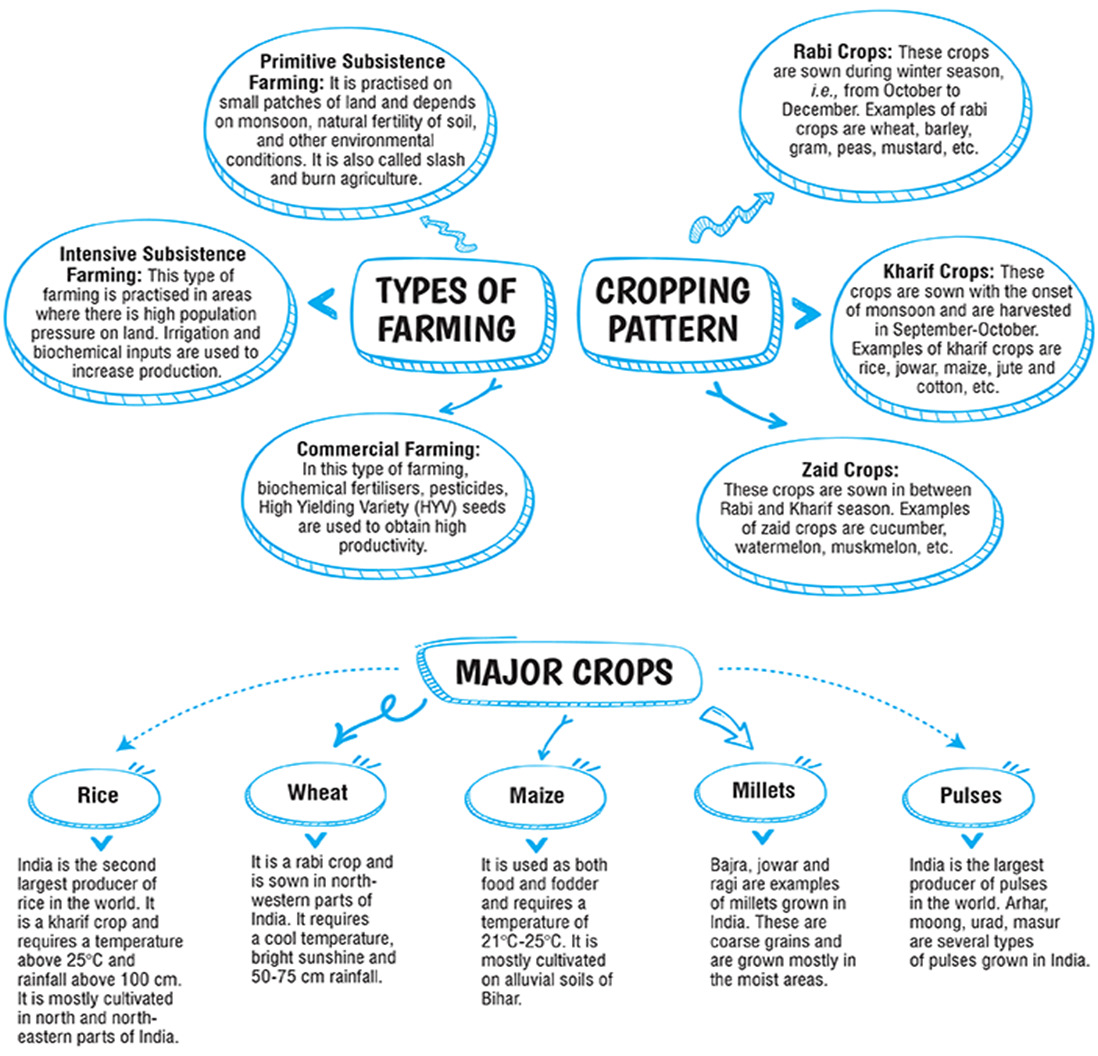I. TYPES OF FARMING
Cultivation techniques depend on the features of the physical environment, technological knowledge, and socio-cultural practices. Farming differs from sustenance to commercial. In various regions of India, the following farming systems exist.
I. Primitive Subsistence Farming
- This type of farming is practiced, in a few pockets of India on small stretches of land using traditional techniques and family/community labor. Farmers clear a patch of land and generate cereals and other food crops to support their family members.
- When soil fertility declines, farmers change and clear a new patch of land for agriculture.
- This form of shifting enables nature to restore soil fertility through natural phenomena.
- Land production is low because farmers do not use fertilizers or other modem inputs.
II. Intensive Subsistence Farming
- It’s practiced in areas with a high population pressure on land. It is labor-intensive farming.
- The yield per hectare is high as many biochemical inputs and irrigation are used.
- The area of land is small and unprofitable.
- Farmers take the maximum output from the limited land by growing 2-3 crops per year from the same land, i.e., multi-cropping.
III. Commercial Agriculture
- In this context, crops are grown mainly for economic uses.
- It is practiced on large pieces of land on scientific and commercial lines using machines and modem innovations.
- Larger use of modern agricultural inputs, e.g. HYV seeds, fertilizers, irrigation, etc.
- The extent of commercialization varies considerably. Rice is a subsistence crop in Odisha, while it is a commercial crop in Punjab. E.g., plantation agriculture.
IV. Commercial Farming
- This method of agriculture uses larger concentrations of modern inputs such as high-yielding varieties (HYV) seeds, chemical fertilizers, insecticides, and pesticides to improve productivity.
- A plantation is a form of economic farming, in which a single crop is grown on a wide scale. Plantations cover huge areas of land, using highly profitable inputs, with the support of migrant workers. All the products are used as raw materials in the industry—for example, Tea, Coffee, Rubber, Sugarcane, and Banana.
II. CROPPING PATTERNS
A. Rabi Crops
| Month Sown | October to December (Winter) |
| Harvest | April to June (Summer) |
| States | North and North Western states like Punjab, Haryana, Himachal Pradesh, Jammu and Kashmir, Uttar Pradesh, and Uttaranchal |
| Success Factors | Availability of precipitation |
| Examples | Wheat, Barley, Mustard, Gram, and Peas. |
B. Kharif Crops
| Month Sown | Onset of Winter |
| Harvest | September to October |
| States | Kerala, Tamil Nadu, Maharashtra, Assam, West Bengal, Punjab and Haryana |
| Examples | Paddy, Maize, Jowar, Bajra, Urad, Cotton, Jute, Groundnut, Soybean |
C. Zaid Crops
| Month Sown and Harvested | Between the Rabi and Kharif season |
| Examples | Watermelon, Muskmelon, cucumber, vegetables and fodder crops |
III. MAJOR CROPS IN INDIA
Apart from the seasonal crops, food crops are consumed by the majority of the country’s population and are elucidated in detail in the chapter on Agriculture in Class 10. The major food crops in India include grains like wheat, rice, millet, maize, and pulses. Other than grains, food crops cultivated include sugarcane, tea, coffee, oilseeds, and horticulture. Also, there are several non-food crops grown in our country which include rubber, cotton, jute, and fibre crops which have been elaborated in the following sections. Let’s take a look at some of the main food crops in India:
I. Food Crops
1. Rice: This is the staple food of a major section of the Indian people and is grown extensively in the northern and northeastern plains, deltas, and coastal areas of India.
2. Wheat: The second most important food crop, wheat is grown extensively in the states of Punjab, Haryana, Bihar, Rajasthan, Uttar Pradesh, and some parts of Madhya Pradesh.
3. Millets: The important millets grown in India include Jowar, Bajra and Ragi. These grains have a high nutritional value.
4. Maize: Maize is a crop used both as a food crop and as fodder. The major states that produce maize in India include Karnataka, Bihar, Uttar Pradesh, Madhya Pradesh, Andhra Pradesh, and Telangana.
5. Pulses: A major source of protein, pulses are produced extensively in the states of Madhya Pradesh, Uttar Pradesh, Rajasthan, Maharashtra, and Karnataka. The major pulses produced in India are Tur, Urad, Moong, Masur, Grama, and Peas.
6. Sugarcane: India is the second-largest producer of sugarcane in the world. It is grown extensively in the states of Bihar, Uttar Pradesh, Maharashtra, Karnataka, Andhra Pradesh, Tamil Nadu, Telangana, Punjab and Haryana.
7. Oilseeds: The major oilseeds produced in India are soybeans, groundnuts, mustard, coconut, sesamum, cotton seeds, castor seeds, linseeds, and sunflowers.
8. Tea: A very important beverage crop, tea is grown in West Bengal, Assam, Himachal Pradesh, Uttarakhand, Meghalaya, Andhra Pradesh, Kerala, Tamil Nadu and Tripura.
9. Coffee: Another major beverage crop, coffee is cultivated in Karnataka, Kerala, and Tamil Nadu.
10. Horticulture Crops: The major horticulture crops in India include fruits like mango, orange, banana, guava, litchi, pineapple, apple, grapes, walnut, apricot, etc., and vegetables like brinjal, potato, tomato, cauliflower, cabbage peas, etc.
II. Non-Food Crops
1. Rubber: In India, rubber is grown in the states of Kerala, Karnataka, Tamil Nadu, Andaman and Nicobar Islands, and Meghalaya.
2. Jute: Popularly known as the golden fiber, jute is produced in the states of West Bengal, Assam, Bihar, Odisha, and Meghalaya.
3. Cotton: A major fibre crop, cotton is grown in the states of Gujarat, Maharashtra, Madhya Pradesh, Karnataka, Telangana, Andhra Pradesh, Tamil Nadu, Punjab, Uttar Pradesh, and Haryana.
4. Fiber crops: Other than jute and cotton, the major fiber crops cultivated in India are hemp and silk. The process of rearing silkworms to obtain silk fiber is known as sericulture.
IV. TECHNICAL AND INSTITUTIONAL REFORMS IN THE FIELD OF AGRICULTURE
We live in a dynamic environment where technological advancement takes place at a fast pace. India is a country with the second-largest population, followed by China as per the 2018 census report. Most of the farmers depend upon natural methodologies of cultivation, which would be challenging to feed millions of empty stomachs. The Government of the country has taken up many initiatives to improve the agricultural sector starting with:
- Land reforms in the first five-year plan.
- Ensure crops against natural disasters.
- Institutions rendering financial assistance to farmers.
- Kisan Credit Card, Personal Accident Insurance Scheme, etc. for farmers.
- Special weather bulletins and agricultural programs hosted through the medium.
- Minimum Support Price, other remuneration, and procurement prices to avoid exploitation against farmers by intermediaries.
V. CONTRIBUTIONS OF AGRICULTURE
During the post-independence period, the agriculture sector contributed a good portion of the nation’s GDP. However, the growth rate in the agriculture sector has considerably diminished over time. Farmers are facing a tough time due to the non-participatory behavior of the Government towards the primary sector. Reduction in the rate of subsidies and import duties are factors discouraging cultivators from continuing in the same line.
VI. FOOD SECURITY
Food, water, clothing, and shelter are the four essentials of humankind. Not every citizen of the country is fortunate to live each day without an empty stomach. There are remote areas prone to natural calamities where economically weaker sections of life don’t have access to nutritional food. The national food security system has been designed by our government, offering a proper remedy for this problem. This system consists of the Buffer stock system and the Public Distribution System. Under the PDS system, food is granted to the economically weaker sections of life at an affordable subsidized price. A buffer stock system is a plan to stabilize the price fluctuations in the commodity by stocking them in warehouses during the surplus period and selling at the time of shortage.
A. IMPACT OF GLOBALISATION ON AGRICULTURE
Going through our class 10 agriculture notes, the next concept you need to study is the impact of globalization on Agriculture. The French and British colonizers came to India due to its indigenous diversity of crops, especially spices. Indian agricultural products have been a reason for the flourishing of various industrial markets in foreign countries. Even with its superior quality, we find it difficult to compete with the products flourishing in the international market. The green revolution promised a higher profit yield and is now replaced with the gene revolution popularly known as genetic engineering. Organic farming is more in trend in the primary sector as it ensures a farming practice in the absence of chemical fertilizers that harness soil quality. A few economists believe that Indian farmers have a bleak future. They opine that diversifying the cropping pattern from cereals to high-value crops will fetch more income and, at the same time, reduce environmental degradation.
B. FACTORS INFLUENCING AGRICULTURE IN INDIA
The various factors that influence agriculture in India. Some of them are as follows:
- Season
- Temperature
- Technology
- Government
- Quality of Land
- Supply and demand in the market
- Availability of Labour
- Transportation facility
C. INSTITUTIONAL REFORMS IN AGRICULTURE
- Collectivization and centralization of property assets to make them commercially feasible.
- The Green Revolution was based on the use of packaging technology and the White Revolution to boost milk production.
- Collaboration with farmers and the abolition of the system of Zamindari.
- Implementation of crop insurance to safeguard farmers against losses due to natural disasters, i.e. drought, flood, cyclone, fire, and disease.
- Formation of Grameen Banks, Cooperative Societies, and Banks.
- Kissan Credit Card (KCC), Personal Accident Insurance Scheme (PAIS).
- Special weather reports and agricultural programs for farmers on radio and television.
- Declaration of minimum support prices, remuneration, and procurement prices for crops to control farmers’ exploitation.




